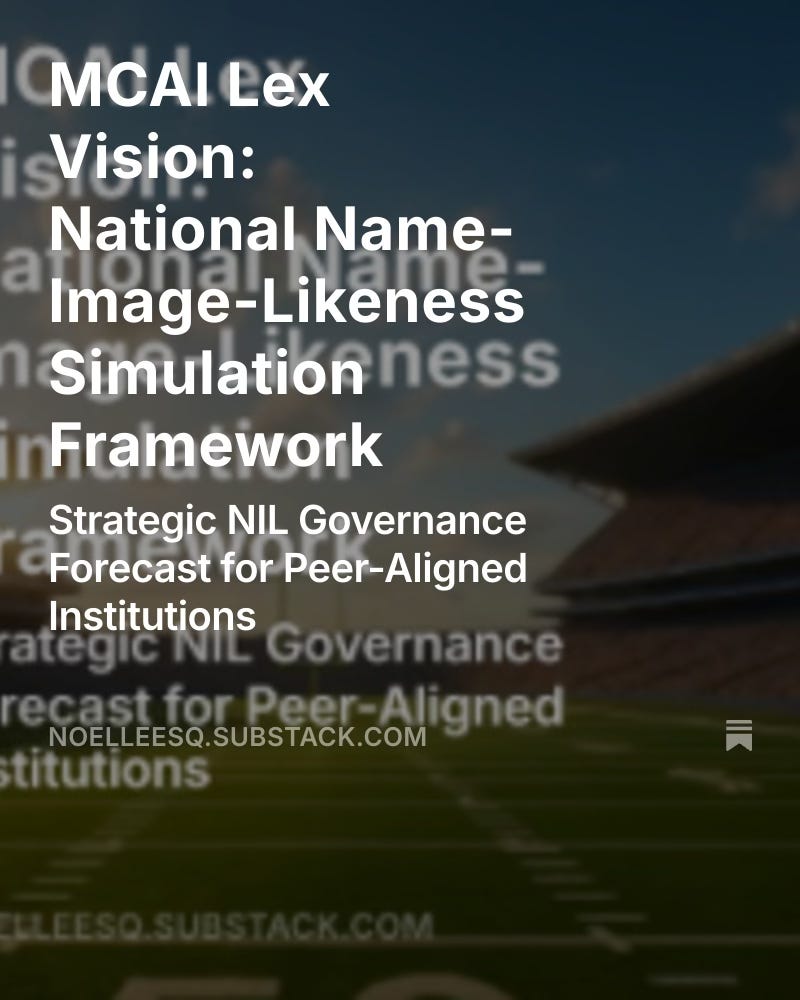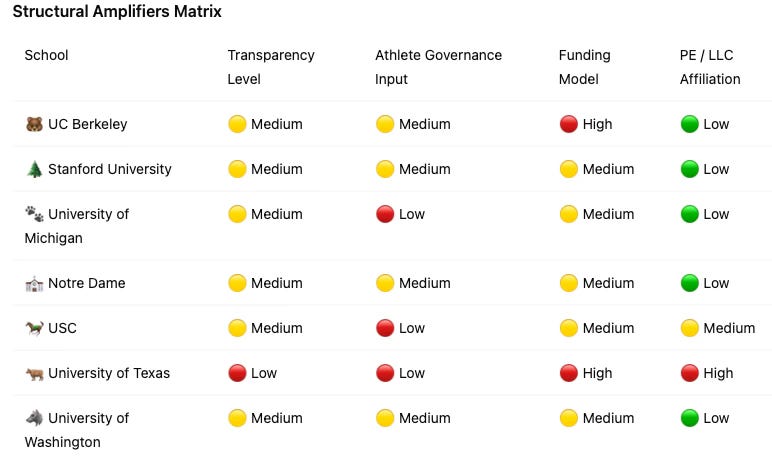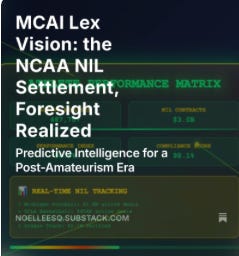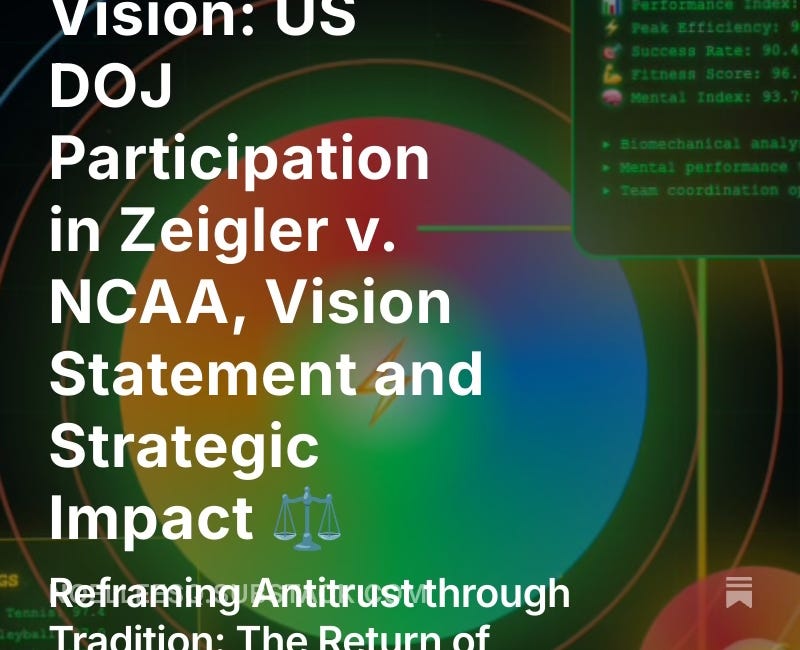MCAI Lex Vision: National Name-Image-Likeness Simulation Framework
Strategic NIL Governance Forecast for Peer-Aligned Institutions
See comparison of standard law and economics NCAA antitrust analysis to MCAI foresight simulation: MCAI Lex Vision: AI-Era Anticipatory Antitrust for NCAA Name-Image-Likeness Compliance, MCAI Simulation Reveals Structural Risk Hidden from Legal Reporting (July 2025)
Executive Summary
The Department of Justice’s June 2025 Statement of Interest in Zeigler v. NCAA fundmentally reframed how courts are likely to evaluate NIL-related antitrust cases. While the Biden-era DOJ favored market mobility and athlete empowerment, the current administration signals a return to educational deference—legitimizing institutional autonomy so long as policies appear tethered to mission. This shift places increased responsibility on schools to proactively demonstrate educational alignment, transparency, and independence of judgment. MCAI simulations are designed to meet this moment: schools that cannot explain their compensation policies beyond 'peer alignment' may find less protection under the DOJ’s new, more deferential lens. For a full strategic forecast, see MCAI’s Lex Vision analysis of the DOJ’s realignment in Zeigler v. NCAA: https://noelleesq.substack.com/p/zeiglerdoj
This report includes a detailed simulation forecast for a selected group of NCAA schools to illustrate how MindCast AI's (MCAI) foresight tools can be applied to low-risk institutions seeking principled leadership positions. In June 2025, the U.S. District Court approved a $2.8 billion settlement in House v. NCAA, allowing schools to share up to 22% of athletics revenue with student-athletes. While the decision formally ended the fiction of amateurism, it introduced a structurally ambiguous model: there is no mandated minimum, no enforcement framework, and no safe harbor from future antitrust claims. Schools face a dual risk—those that underpay athletes may face equity, Title IX, and reputational backlash, while those that uniformly adopt a 22% ceiling without internal justification may be accused of collusive wage suppression.
MCAI helps universities navigate this ambiguity not through compliance checklists, but through strategic foresight. Using a proprietary tiered variable model and cognitive digital twin (CDT) simulations, MCAI evaluates governance centralization, labor exposure, transparency, funding models, and private equity/LLC structures to forecast legal, reputational, and equity-based risks. MCAI helps presidents, general counsels, and trustees see beyond policy adoption to scenario divergence—offering a simulated map of trust degradation, legal vulnerability, and governance resilience.
This report applies the MCAI framework, showing how differences in structure, mission, and voice create wide differences in antitrust exposure. We identify not only which schools are vulnerable—but why, and how they can evolve before pressure turns to litigation. Beyond evaluating current risk, MCAI enables forward-looking policy development. By forecasting how compensation models interact with governance structures, public trust, and evolving regulatory trends, MCAI helps institutions design durable name-image-likeness (NIL) frameworks that can withstand legal, media, and mission-based scrutiny.
MCAI allows presidents and boards to model 'what if' scenarios—including shifting conference norms, emerging Title IX claims, or private equity pressures—before they materialize. In an environment where policy timing is as important as policy content, MCAI transforms insight into preemptive strategy. This report evaluates seven nationally prominent institutions using MCAI’s antitrust variable matrix, offering tailored insights for strategic, compliant NIL governance.
I. Methodology and Framework
This report applies the MCAI antitrust risk framework to a selection group of institutions, each evaluated across a tiered variable model that accounts for legal exposure, institutional structure, and foresight capacity. Schools were selected based on diversity in athletic revenue, governance type, public/private status, and NIL market visibility. The MCAI model uses a three-tier classification: Primary Risk Drivers (direct antitrust exposure), Structural Amplifiers (contextual or transparency-based risk enhancers), and Context Variables (identity and governance environment).
MindCast AI’s simulation capability centers on Cognitive Digital Twin (CDT) modeling—virtualized representations of key stakeholders who influence NIL strategy outcomes. Each MCAI simulation generates predictive outputs through CDT scenario stress testing. Outcomes are analyzed across legal defensibility, stakeholder alignment, and governance resilience. These simulations help institutions design NIL policies that are not only compliant—but strategic, transparent, and institutionally durable. These CDTs reflect the behavioral patterns, institutional incentives, and regulatory signals of groups such as trustees, faculty, student-athletes, peer institutions, and regulators. For each institution, MCAI constructs scenario-based policy models to simulate stakeholder responses, ranging from governance board approval to student-athlete retention and regulatory scrutiny.
Scenarios may include academic-tied compensation structures, market-competitive models, values-based leadership strategies, or minimal compliance approaches. Each scenario is stress-tested for legal viability, institutional alignment, and strategic foresight across four Vision Functions: Legal, Economic, Trust, and Legacy. This process allows schools not only to assess current risk but to optimize policy outcomes before implementation—turning NIL design into an anticipatory governance asset.
II. Institution Overview
This simulation includes seven high-visibility universities representing a diverse range of governance models, athletic revenue structures, and NIL risk exposure levels. Each institution was selected for its strategic relevance to NIL policy evolution and its high degree of overlap with peer institutions across MCAI’s variable tiers. Schools were grouped based on scenario clustering and CDT alignment: Power Governance Risk (USC, Texas, Michigan), Transparent Reform (Washington, Stanford, UC Berkeley), and Institutional Independence (Notre Dame).
🐻 University of California, Berkeley: A public flagship with strong football visibility, academic prestige, and moderate transparency. Berkeley straddles NIL policy tension between its public mission and Power Five pressures. Berkeley operates within one of the most regulated and public-facing university systems in the country. Its NIL decisions are likely to be benchmarked nationally, especially in balancing public trust and Power Five competitiveness.
🌲 Stanford University: A private institution with high brand integrity and relatively low PE/LLC exposure. Stanford’s governance culture supports mission-driven NIL positioning and reputational leverage. Stanford’s strategic advantage lies in its ability to position NIL as an extension of its innovation ethos. It may lead through reputational signaling even without aggressive compensation figures.
🐾 University of Michigan: A top-tier public university with strong centralized athletic governance and national media presence. Michigan’s NIL strategy carries high compliance visibility and labor market exposure. Michigan must balance national competitiveness with public transparency. Its NIL posture will likely influence peer behavior across the Big Ten.
⛪ University of Notre Dame: As an independent and religiously affiliated school, Notre Dame has structural flexibility but must balance market competitiveness with mission clarity. Its independence gives it freedom—but also scrutiny—when aligning or diverging from Power Five norms. Donor expectations and institutional identity must remain harmonized.
🐎 University of Southern California: A media-visible, Big Ten-aligned private school with high structural exposure. USC faces NIL risks through both governance centralization and market conformity. USC's NIL outcomes will be closely watched as a test case for private schools navigating Big Ten realignment. The school’s narrative strategy is as important as its pay model.
🐂 University of Texas: A flagship SEC member with elite sports exposure, centralized NIL leadership, and high booster involvement. Texas represents one of the highest-profile risk environments in this cohort. As a bellwether program, Texas is likely to trigger reputational cascades across the SEC depending on its NIL framing. Managing booster influence and structural risk is critical.
🐺 University of Washington: A well-governed public institution with growing NIL exposure but retained policy flexibility. Washington may model how public schools scale NIL strategy without triggering structural risk. Washington’s ability to combine policy agility with transparency gives it a reform leadership edge. Its decisions may shape expectations for public schools outside the SEC/Big Ten axis.
III. Risk Matrices by Institution
Below are the risk scoring matrices for each of the seven institutions across MCAI’s three-tiered framework. Scores reflect each school’s status across Primary Risk Drivers (direct legal exposure), Structural Amplifiers (policy transparency and athlete voice), and Context Variables (institutional environment). Color codes reflect MCAI thresholds: 🔴 = High Risk, 🟡 = Medium Risk, 🟢 = Low Risk.
IV. Variable Classification Framework
Risk Scoring Logic
All risk scores in this report use a three-tier system:
🟢 Low Risk: The school demonstrates clear structural, governance, or contextual factors that reduce exposure.
🟡 Medium Risk: Conditions are mixed or evolving, with moderate exposure and incomplete safeguards.
🔴 High Risk: The variable triggers direct antitrust, reputational, or fiduciary vulnerability.
Thresholds vary by variable—for example:
Labor Market Exposure: 🔴 = FBS football or elite men's basketball with national media presence; 🟡 = regional visibility with partial exposure; 🟢 = limited NIL participation
Governance Type: 🔴 = centralized, opaque, or booster-influenced; 🟡 = mixed structure; 🟢 = distributed with advisory input
The core variables MCAI uses to evaluate NIL-related antitrust and compliance risk are present to some degree in each school. MCAI groups the variables by structural impact—whether it directly triggers legal exposure, amplifies risk through governance gaps, or reflects environmental context. Schools are then scored across these variables using a three-level system (🟢 Low, 🟡 Medium, 🔴 High), with visual matrices for comparison. This tiered approach allows institutions to identify their most urgent liabilities and calibrate their policy design accordingly.
Primary Risk Drivers
Policy Uniformity Risk: This variable measures whether a school’s compensation model mimics peer institutions without internal justification. 🔴 High risk arises when schools appear to coordinate wage ceilings or adopt peer policies without public rationale. 🟢 Low risk schools show transparent, institutionally grounded approaches to NIL policy.
Governance Type: This variable reflects how decision-making about athletics and NIL policy is structured institutionally. 🔴 Centralized models with opaque authority structures increase the appearance of collusion or anticompetitive alignment. 🟢 Distributed governance with public-facing policy review mechanisms demonstrates autonomy.
Labor Market Exposure: This variable gauges how visible and commercially relevant a school is in the NIL ecosystem—especially in football and men’s basketball. 🔴 High exposure schools face heightened risk of wage suppression claims. 🟢 Low exposure schools can justify more conservative or education-focused NIL models.
Structural Amplifiers
Transparency Level: This variable measures whether schools disclose their NIL policy structure, stakeholder involvement, and budget decisions. 🔴 Low transparency can signal bad faith or concealment. 🟢 High transparency demonstrates regulatory goodwill and builds institutional trust.
Athlete Governance Input: This variable assesses whether athletes participate in decision-making, budget discussions, or NIL rulemaking. 🟢 High athlete input strengthens legal defensibility and institutional credibility. 🔴 Low or no athlete input increases risk of future legal or reputational challenge.
Funding Model: This variable reflects how schools finance their athletic departments—via student fees, tuition, media deals, or donor collectives. 🔴 Tuition-heavy or debt-driven models with low NIL payout rates are more exposed to fairness-based criticism. 🟢 Revenue-sharing from external media or donor funds improves compliance viability.
Private Equity / LLC Affiliation: This variable flags commercial structuring risks. 🔴 PE or LLC-based athletic operations may appear designed to insulate schools from liability but can trigger scrutiny if not paired with transparency and athlete protections. 🟢 Institutions that retain public oversight and equity safeguards minimize reputational and legal vulnerability.
Context Variables
NCAA Division: This variable tracks the school’s competitive and regulatory environment. 🔴 Division I institutions with FBS football programs face greater scrutiny due to scale, visibility, and revenue pressures. 🟢 D-II and D-III institutions face different but often more manageable NIL design expectations.
Conference: This variable identifies whether schools belong to tightly coordinated leagues. 🔴 Power 5 or historically consolidated conferences face greater risk of groupthink-based legal challenge. 🟢 Independents or loosely affiliated programs can better assert autonomy.
Public vs. Private: This variable captures how regulatory expectations differ by governance structure. 🟡 Public schools face FOIA requests and legislative oversight; 🟡 Private schools face less formal scrutiny but more donor and media pressure.
Major Sports Profile: This variable captures the extent to which high-revenue sports shape a school’s brand and compensation narrative. 🔴 Schools with elite men’s basketball or FBS football programs face the greatest NIL risk and pressure. 🟢 Smaller schools with distributed athletic programs or low national visibility face less stakeholder and regulator attention.
V. Cluster I: Power Governance Risk – USC, Texas, Michigan
Note: While grouped based on shared high exposure across MCAI variables, each institution within this cluster maintains distinct governance structures and stakeholder dynamics. Michigan's faculty influence differs from USC’s private board leadership, while Texas faces unique political and donor-driven constraints. These differences shape how risk manifests and how policy should be implemented.
This cluster includes institutions operating at the top of the NIL exposure spectrum. They are nationally visible, policy-influential, and carry the highest risk of antitrust scrutiny due to uniformity, labor visibility, and centralized NIL governance. The following scenarios forecast their policy response options and show how transparency and internal voice can mitigate systemic risk. These schools benefit most from strategic flexibility layered with visible athlete and stakeholder governance mechanisms.
Shared Profile:
🔴 High Policy Uniformity Risk: These schools are likely to adopt similar NIL frameworks due to peer pressure, media visibility, or internal governance inertia. This creates significant legal risk under antitrust scrutiny. A failure to show independent rationale could trigger claims of horizontal coordination.
🔴 High Labor Market Exposure: Each school maintains high-profile FBS football and men's basketball programs, placing them at the center of NIL market expectations. Athletes at these institutions are more visible and more likely to demand aggressive compensation. Legal vulnerability grows when compensation lags visibility or market comparison.
🔴 Centralized Governance: Decision-making is top-down, often from athletic departments or central boards, with limited athlete input. This structure increases the risk of opaque policy setting that lacks stakeholder legitimacy. Antitrust exposure rises when governance patterns replicate those seen in past labor-market collusion cases.
🟡 Moderate Transparency: While not fully opaque, these schools provide limited public insight into how NIL policies are structured or reviewed. Lack of transparency creates uncertainty for athletes, fans, and regulators alike. Disclosure gaps weaken compliance optics.
🔴 High Contextual Risk (FBS, Big Ten/SEC power footprint): These institutions operate within the most commercially saturated athletic ecosystems in the country. Their Power Five status magnifies legal and media scrutiny. Context alone increases the burden of defensibility for their NIL models.
Scenario Forecasts:
Scenario A: 22% Ceiling Policy
This scenario mimics the court-sanctioned ceiling without offering institutional variation or athlete engagement. It provides short-term clarity but increases long-term legal risk due to potential horizontal coordination. While administratively simple, it weakens narrative legitimacy.
🔴 Regulatory Risk: High
🔴 Stakeholder Trust: Low among athletes, moderate among boards
🟡 Competitive Positioning: Stable but reputation-vulnerable
Scenario B: Tiered Compensation + Athlete Council
This structure allows internal flexibility while avoiding a hard cap, reducing the chance of uniformity claims. Athlete input demonstrates good faith, especially in Title IX and equity audits. Its effectiveness depends on public communication and clarity of governance roles.
🟡 Regulatory Risk: Moderate
🟡 Trust: Improved across internal stakeholders
🟡 Competitive Position: Positive media framing potential
Scenario C: Transparent NIL Disclosure with Flex Band
This approach builds strong legal and reputational foundations, especially with public reporting. It sacrifices short-term recruiting optics for long-term mission alignment. If positioned as a values-driven standard, it can influence national discourse.
🟢 Regulatory Risk: Low
🟢 Trust: High institutional alignment
🔴 Competitive Position: May face pushback from boosters if compensation appears modest
VI. Cluster II: Transparent Reform – Washington, Stanford, UC Berkeley
Note: Some institutions in this cluster, such as Stanford, also exhibit characteristics of Cluster III due to strong mission framing. Others like Washington share moderate structural risks with Cluster I peers. Cluster assignment reflects dominant traits but does not preclude cross-alignment.
Institutions in this cluster operate with moderate governance risk but high reputational leverage. While still exposed through football visibility, these schools have structural opportunity to lead through trust-based NIL innovation. The following scenarios forecast the trade-offs between cautious compliance and bold mission-centered experimentation. This group stands to gain national credibility by demonstrating foresight in both process and substance.
Shared Profile:
🟡 Medium Policy Uniformity and Governance Risk: These institutions retain more policy autonomy than their Power Five peers but still face internal and external coordination pressures. Their governance structures tend to allow more faculty and institutional input, which reduces risk but doesn’t eliminate it. Without clear public differentiation, they may still appear to be harmonizing with peers.
🟢 Low PE/LLC Affiliation: These schools are not currently entangled in private equity deals or LLC-style athletic governance. This minimizes perceived commercialization risk and regulatory red flags. However, continued vigilance is needed if market pressures change.
🔴 High Labor Exposure (esp. football): Even with less aggressive NIL positioning, these institutions operate in highly visible football ecosystems. That visibility creates expectations for athlete compensation and mobility. Any failure to align with those expectations carries legal and reputational consequences.
🟡 Moderate Athlete Input and Transparency: Some structures for student-athlete engagement exist but lack formal authority or public visibility. This offers partial protection against scrutiny but still leaves questions about governance integrity. Improved disclosure and advisory mechanisms could close this gap.
🟢 High potential for trust-driven policy leadership: These institutions are better positioned to model ethical, foresight-based NIL approaches. Stakeholders are more likely to reward principled innovation than performative compliance. If executed transparently, they could reset national expectations.
Scenario Forecasts:
Scenario A: Range-Based Compensation Model with Public Reports
This model allows compensation variation by sport or market while maintaining transparency. It reduces risk of uniformity accusations but can appear underwhelming without strategic communication. Supplementary benefits or co-governance boards could strengthen athlete buy-in.
🟢 Trust & Reputation: Very high
🔴 Regulatory Risk: If Ivy coordination-style caps mimic collusion structure
Scenario B: Mission-Aligned NIL Tied to Educational Incentives
This model reframes NIL as part of the academic journey, not as a parallel marketplace. It may attract regulator attention if coordinated across peer institutions without independent review. Still, it offers powerful alignment with faculty values and long-term mission goals.
🟡 Stakeholder Trust: Strong among faculty and trustees
🟡 Regulator Risk: Low, especially if paired with public disclosures
🔴 Athlete Trust: Could erode if peer schools are more aggressive
Scenario C: Status Quo with Discreet Booster Involvement
This approach is often the default when institutions fear stakeholder blowback. It may seem safe in the short term but becomes legally and reputationally fragile under scrutiny. If boosters control compensation without transparency, the institution inherits the liability without the narrative control.
🔴 Trust: Vulnerable to exposure-based reputational collapse
🔴 Regulator Risk: High if PE/LLC actors aren’t disclosed
VII. Cluster III: Institutional Independence – Notre Dame
Notre Dame represents a standalone strategic case given its independent status and values-driven governance. While its NIL policy risk is structurally lower, peer visibility and alignment concerns still matter. The following scenarios forecast how alignment with mission or over-calibration to market norms can affect stakeholder trust and regulatory posture. As a model of principled independence, Notre Dame’s actions could influence peer expectations well beyond its conference status.
Profile Highlights:
🟡 Medium Governance Centralization: Notre Dame’s hybrid structure allows some decentralization but retains key decision-making at the institutional level. This avoids the extremes of either full opacity or full faculty governance. It offers strategic maneuverability but still requires transparency.
🟢 Low Conference Risk (Independent): As a non-member of a Power Five conference, Notre Dame avoids the appearance of collusive policy setting. This independence provides legal insulation and narrative control. However, policy similarity with peer institutions could still draw scrutiny.
🟢 Strong Institutional Mission Framing: Notre Dame can credibly tie NIL policy to religious, academic, and ethical commitments. This provides a built-in rationale for compensation decisions that deviate from market logic. Properly leveraged, this framing boosts defensibility.
🟡 Moderate Transparency and Athlete Input: Notre Dame’s current practices include limited public reporting and informal athlete voice. This creates a perception gap that may raise future questions. Formal advisory structures and transparency reporting could enhance legitimacy.
Scenario Forecasts:
Scenario A: Athlete Endowment Model (Alumni-Funded Trust)
This policy allows schools to sidestep booster chaos while preserving their public brand. By aligning NIL with long-term academic or mission goals, the trust model builds resilience. Its success depends on alumni enthusiasm and governance transparency.
🟢 Stakeholder Trust: High
🟢 Regulatory Risk: Minimal if transparent
🟡 Competitive Risk: Medium – less aggressive than peers
Scenario B: Market-Mirroring with Religious Mission Shield
This scenario tries to blend competitiveness with narrative insulation. It risks appearing hypocritical if market alignment is clear but couched in symbolic framing. Regulators and athletes may interpret it as pretext without transparent variation or input.
🔴 Legal Risk: Medium-High if functionally mirrors conference restraints
🟡 Trust: Depends on public messaging alignment
VIII. Simulation Summary and Strategic Recommendations
MCAI recommends Scenario B or C for most Tier I schools, provided transparency and athlete governance are strengthened. For Tier II reform-minded institutions, Scenario A yields the strongest trust outcomes. Notre Dame should consider Scenario A while actively simulating stakeholder reactions to any public NIL pivot.
By forecasting beyond policy adoption, MCAI helps institutions transform NIL strategy from legal risk into leadership advantage.
University trustees and executive teams must now treat NIL governance as a domain of fiduciary strategy—not just compliance or athletic oversight. The DOJ’s repositioning in Zeigler v. NCAA elevates the importance of institutional autonomy and educational alignment, but removes prior assumptions of federal protection. Boards must ensure NIL policy design reflects mission clarity, transparency, and athlete engagement to mitigate exposure to legal, reputational, and Title IX risk.
MCAI recommends:
Boards implement NIL policy reviews as part of annual fiduciary audits.
Institutions establish athlete governance councils with formal policy input rights.
Compensation structures should include a public rationale linked to academic mission.
Schools using LLCs, PE partnerships, or third-party booster channels must disclose governance protocols.
Presidents and trustees must now lead—not defer—NIL governance. The legal shield is shifting from federal deference to documented institutional foresight.
Prior MCAI work on the NCAA antitrust settlement
MCAI Lex Vision: the NCAA NIL Settlement, Foresight Realized
On June 6, 2025, the United States District Court for the Northern District of California approved a landmark $2.8 billion settlement in House v. NCAA, authorizing colleges to directly compensate athletes for their name, image, and likeness (NIL). Judge Claudia Wilken’s ruling redefined the structure of college athletics and formally ended the legal fic…









